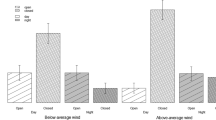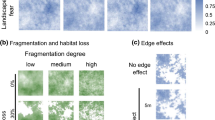Abstract
Prey living in risky environments can adopt a variety of behavioral tactics to reduce predation risk. In systems where predators regulate prey abundance, it is reasonable to assume that differential patterns of habitat use by prey species represent adaptive responses to spatial variation in predation. However, patterns of habitat use also reflect interspecific competition over habitat. Collared (Dicrostonyx groenlandicus) and brown (Lemmus trimucronatus) lemmings represent such a system and possess distinct upland tundra versus mesic meadow habitat preferences consistent with interspecific competition. Yet, we do not know whether this habitat preference might also reflect differences in predation risk or whether the two species differ in their behavioral tactics used to avoid predation. We performed experiments where we manipulated putative predation risk perceived by lemmings by increasing protective cover in upland and meadow habitats while we recorded lemming activity and behavior. Both lemming species preferentially used cover more than open patches, but Dicrostonyx was more vigilant than Lemmus. Both species also constrained their activity to protective patches in upland and meadow habitats, but during different periods of the day. Use of cover and vigilance were independent of habitat, suggesting that both species live in a fearsome but flattened landscape of fear at Walker Bay (Nunavut, Canada), and that their habitat preference is a consequence of competition rather than predation risk. Future studies aiming to map the contours of fear in multi-prey–predator systems should consider how predation and competition interact to modify prey species’ habitat preference, patch use, and vigilance.




Similar content being viewed by others
References
Ale SB, Morris DW, Dupuch A, Moore DE (2011) Habitat selection and the scale of ghostly coexistence among Arctic rodents. Oikos 120:1191–1200
Angerbjörn A, Tannerfeldt M, Erlinge S (1999) Predator–prey relations: lemmings and arctic foxes. J Anim Ecol 68:34–49
Bates D, Maechler M, Bolker B (2011) Lme4: linear mixed-effects models using S4 classes. R package version 0.999375-42
Batzli GO (1993) Food selection by lemmings. In: Stenseth NC, Ims RA (eds) The biology of lemmings. Academic, New York, pp 281–301
Batzli GO, Pitelka FA, Cameron GN (1983) Habitat use by lemmings near Barrow, Alaska. Holarctic Ecol 6:255–262
Beauchamp G (2008) What is the magnitude of the group-size effect on vigilance? Behav Ecol 19:1361–1368
Brown JS (1988) Patch use as an indicator of habitat preference, predation risk, and competition. Behav Ecol Sociobiol 22:37–47
Brown JS (1999) Vigilance, patch use and habitat selection: foraging under predation risk. Evol Ecol Res 1:49–77
Brown JS, Kotler BP (2004) Hazardous duty pay and the foraging cost of predation. Ecol Lett 7:999–1014
Brown JS, Kotler BP (2007) Foraging and the ecology of fear. In: Stephens DW, Brown JS, Ydenberg RC (eds) Foraging behavior and ecology. University of Chicago Press, Chicago, pp 437–480
Brown JS, Morgan RA, Dow BD (1992) Patch use under predation risk: II. A test with fox squirrels, Sciurus niger. Ann Zool Fenn 29:311–318
Brown JS, Laundré JW, Gurung M (1999) The ecology of fear: optimal foraging, game theory, and trophic interactions. J Mammal 80:385–399
Burnham KP, Anderson DR (2002) Model selection and multimodel inference: a practical information-theoretic approach. Springer, New York
China V, Kotler BP, Shefer N, Brown JS, Abramsky Z (2008) Density-dependent habitat and patch use in gerbils: consequences of safety in numbers? Isr J Ecol Evol 54:373–388
Dall SRX, Kotler BP, Bouskila A (2001) Attention, apprehension and gerbils searching in patches. Ann Zool Fenn 38:15–23
Devereux CL, Whittingham MJ, Fernandez-Juricic E, Vickery JA, Krebs JR (2006) Predator detection and avoidance by starlings under differing scenarios of predation risk. Behav Ecol 17:303–309
Dupuch A, Dill LM, Magnan P (2009) Testing the effects of resource distribution and inherent habitat riskiness on simultaneous habitat selection by predators and prey. Anim Behav 78:705–713
Dupuch A, Morris DW, Ale SB, Wilson DJ, Moore DE (2013) Landscapes of fear or competition? Predation did not alter habitat choice by Arctic rodents. Oecologia (published online, doi: 10.1007/s00442-013-2792-7)
Eccard JA, Liesenjohann T (2008) Foraging decisions in risk-uniform landscapes. PloS ONE 3:e3438
Embar K, Kotler BP, Mukherjee S (2011) Risk management in optimal foragers: the effect of sightlines and predator type on patch use, time allocation, and vigilance in gerbils. Oikos 120:1657–1666
Gauthier G, Bêty J, Giroux J-F, Rochefort L (2004) Trophic interactions in a high arctic snow goose colony. Integr Comp Biol 44:119–129
Gauthier G, Berteaux D, Krebs CJ, Reid D (2009) Arctic lemmings are not simply food limited—a comment on Oksanen et al. Evol Ecol Res 11:483–484
Gilg O, Hanski I, Sitller B (2003) Cyclic dynamics in a simple vertebrate predator–prey community. Science 302:866–868
Gilg O, Sittler B, Sabard B, Hurstel A, Sane R, Delattre P, Hanski I (2006) Functional and numerical responses of four lemming predators in high arctic Greenland. Oikos 113:193–216
Grand TC, Dill LM (1997) The energetic equivalence of cover to juvenile coho salmon (Oncorhynchus kisutch): ideal free distribution theory applied. Behav Ecol 8:437–447
Hammond JI, Luttbeg B, Sih A (2007) Predator and prey space use: dragonflies and tadpoles in an interactive game. Ecology 88:1525–1535
Hanski I, Hentonnen H (1996) Predation on competing rodent species: a simple explanation to complex patterns. J Anim Ecol 65:220–232
Heithaus MR, Wirsing AJ, Frid A, Dill LM (2007) Behavioral indicators in marine conservation: lessons from a pristine seagrass ecosystem. Isr J Ecol Evol 53:355–370
Holt RD (1977) Predation, apparent competition and the structure of prey communities. Theor Popul Biol 12:197–229
Holt RD, Kotler BP (1987) Short-term apparent competition. Am Nat 130:412–430
Hugie DM, Dill LM (1994) Fish and game: a game theoretic approach to habitat selection by predators and prey. J Fish Biol 45:151–169
Kotler BP (1997) Patch use by gerbils in a risky environment: manipulating food and safety to test four models. Oikos 78:274–282
Kotler BP, Brown JS, Hasson 0 (1991) Owl predation on gerbils: the role of body size, illumination, and habitat structure on rates of predation. Ecology 72:2249–2260
Kotler BP, Blaustein L, Brown JS (1992) Predator facilitation: the combined effect of snakes and owls on the foraging behavior of gerbils. Ann Zool Fenn 29:2249–226
Kotler BP, Brown JS, Mukherjee S, Berger-Tal O, Bouskila A (2010) Moonlight avoidance in gerbils reveals a sophisticated interplay among time allocation, vigilance and state-dependent foraging. Proc Roy Soc Lond B 277:1469–1474
Krause J, Ruxton GD (2002) Living in groups. Oxford University Press, New York
Krebs CJ (1964) The lemming cycle at Baker Lake, Northwest Territories, during 1959–1962. Arctic Institute of North America Technical Paper 15:1–104
Krebs CJ (2011) Of lemmings and snowshoe hares: the ecology of northern Canada. Proc Roy Soc Lond B 278:481–489
Laundré JW, Hernández L, Altendorf KB (2001) Wolves, elk & bison: reestablishing the “landscape of fear” in Yellowstone National Park USA. Can J Zool 79:1401–1409
Laundré JW, Hernández L, Ripple WJ (2010) The landscape of fear: ecological implications of being afraid. Open Ecol J 3:1–7
Legagneux P, Gauthier G, Berteaux D, Bêty J, Cadieux M-C, Bilodeau F, Bolduc E, McKinnon L, Tarroux A, Therrien J-F, Morissette L, Krebs CJ (2012) Disentangling trophic relationships in a high arctic tundra ecosystem through food web modeling. Ecology 93:1707–1716
Morris DW (2005a) Habitat-dependent foraging in a classic predator–prey system: a fable from snowshoe hares. Oikos 109:239–254
Morris DW (2005b) Paradoxical avoidance of enriched habitats: have we failed to appreciate omnivores? Ecology 86:2568–2577
Morris DW (2009) Apparent predation risk: tests of habitat selection theory reveal unexpected effects of competition. Evol Ecol Res 11:209–225
Morris DW, Dupuch A (2012) Habitat change and the scale of habitat selection: shifting gradients used by coexisting Arctic rodents. Oikos 121:783–789
Morris DW, Davidson DL, Krebs CJ (2000) Measuring the ghost of competition: insights from density-dependent habitat selection on the coexistence and dynamics of lemmings. Evol Ecol Res 2:41–67
Morris DW, Dupuch A, Halliday WD (2012) Climate-induced habitat selection predicts future evolutionary strategies of lemmings. Evol Ecol Res 14:689–705
Oksanen L (1983) Trophic exploitation and arctic phytomass patterns. Am Nat 122:45–52
Oksanen T, Oksanen L, Dahgren J, Olofsson J (2008) Arctic lemmings, Lemmus spp. and Dicrostonyx spp.: integrating ecological and evolutionary perspectives. Evol Ecol Res 10:415–434
Oksanen T, Oksanen L, Dahlgren J, Olofsson J, Kyrö K (2009) On the implications of currently available data on population fluctuations of arctic lemmings—reply to Gauthier et al. Evol Ecol Res 11:485–487
Pinheiro J, Bates D, DebRoy S, Sarkar D, R Development Core Team (2012) nlme: linear and nonlinear mixed effects models. R package version 3.1–105. URL: http://cran.r-project.org/web/packages/nlme. Accessed 6 July 2012
Pitelka FA, Batzli GO (1993) Distribution, abundance and habitat use by lemmings on the north slope of Alaska. In: Stenseth NC, Ims RA (eds) The biology of lemmings. Academic, New York, pp 213–236
Predavec M, Krebs CJ (2000) Microhabitat utilization, home ranges, and movement patterns of the collared lemming (Dicrostonyx groenlandicus) in the central Canadian Arctic. Can J Zool 78:1885–1890
Pulliam HR (1973) On the advantages of flocking. Theor Biol 38:419–422
R Development Core Team (2011) R: a language and environment for statistical computing. R Foundation for Statistical Computing, Vienna, Austria, URL http://www.R-project.org/. Accessed 1 Jan 2011
Roberts G (1996) Why individual vigilance declines as group size increases. Anim Behav 51:1077–1086
Rodgers AR, Lewis MC (1986) Diet selection in Arctic lemmings (Lemmus sibiricus and Dicrostonyx groenlandicus): demography, home range, and habitat use. Can J Zool 64:2717–2727
Schmidt NM, Berg TB, Forchhammer MC, Hendrichsen DK, Kyhn LA, Meltofte H, Hoye TT (2008) Vertebrate predator–prey interactions in a seasonal environment. Adv Ecol Res 40:345–370
Sekhon JS (2011) Multivariate and propensity score matching software with automated balance optimization: the matching package for R. J Stat Softw 42:1–52
Slotow R, Coumi N (2000) Vigilance in bronze mannikin groups: the contributions of predation risk and intra-group competition. Behaviour 137:565–578
Treves A (2000) Theory and method in studies of vigilance and aggregation. Anim Behav 60:711–722
van der Merwe M, Brown JS (2008) Mapping the landscape of fear of the cape ground squirrel (Xerus inauris). J Mammal 89:1162–1169
Watson A (1956) Ecological notes on the lemmings Lemmus trimucronatus and Dicrostonyx groenlandicus in Baffin Island. J Anim Ecol 25:289–301
Werner EE, Gilliam JF, Hall DF, Mittelbach GG (1983) An experimental test of the effects of predation risk on habitat use in fish. Ecology 64:1540–1548
Wilson DJ, Bromley RG (2001) Functional and numerical responses of predators to cyclic lemming abundances: effects on loss of goose nests. Can J Zool 79:525–532
Wilson DJ, Krebs CJ, Sinclair ARE (1999) Limitation of collared lemming populations during a population cycle. Oikos 87:382–398
Acknowledgments
We thank Canada’s International Polar Year program “Arctic Wildlife Observatories Linking Vulnerable EcoSystems”, Natural Sciences and Engineering Research Council, Department of Indian and Northern Affairs, Northern Scientific Training Program, and Polar Continental Shelf Project (Natural Resources Canada), for financial and logistical support. We also thank Lakehead University’s Northern Studies Committee and Canada’s Summer Career Placements program for student support and the Government of Nunavut for permission and facilities to conduct this research. Our tests of predation’s effects on lemming habitat use benefitted from the assistance and cooperation of G. Gauthier, S. Vijayan, M. Moses, and R.W. Buchkowski. This contribution was improved by candid and helpful comments by B. Kotler and an anonymous referee. We thank you.
Ethical standards
All experiments complied with animal utilization protocols certified by the Lakehead University Animal Care Committee.
Conflict of interest
The authors declare that they have no conflict of interest.
Author information
Authors and Affiliations
Corresponding author
Additional information
Communicated by E. Korpimäki
Rights and permissions
About this article
Cite this article
Dupuch, A., Morris, D.W. & Halliday, W.D. Patch use and vigilance by sympatric lemmings in predator and competitor-driven landscapes of fear. Behav Ecol Sociobiol 68, 299–308 (2014). https://doi.org/10.1007/s00265-013-1645-z
Received:
Revised:
Accepted:
Published:
Issue Date:
DOI: https://doi.org/10.1007/s00265-013-1645-z




